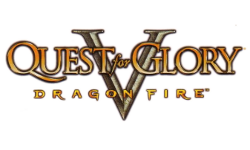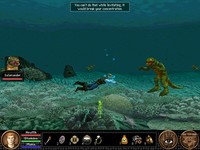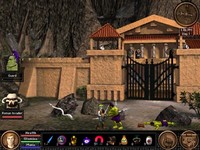|
|

|
PLATFORM
|
PC
|
BATTLE SYSTEM
|

|
INTERACTION
|

|
ORIGINALITY
|

|
STORY
|

|
MUSIC & SOUND
|

|
VISUALS
|

|
CHALLENGE
|
Moderate
|
COMPLETION TIME
|
Less than 20 Hours
|
|
OVERALL

|
+ Ties up a lot of loose ends
+ Good soundtrack and voice acting
+ Stealth missions are fun
- Too zoomed out
- Point-and-click interface needs work
- Silmaria is populated by floating bobbleheads
|
Click here for scoring definitions
|
|
|
How does one end a series? Hopefully with a bang and not a whimper, but that's a difficult thing to arrange. It helps that Quest for Glory V: Dragon Fire was always intended to be the capstone of a four-part (later a five-part) storyline, but there's still a balance, a happy medium which must be found. Was Sierra On-Line able to get there? That's hard to say, as tastes and opinions vary, but for me it fell a bit short of what I felt it could be.
The story is introduced in a massive FMV sequence unlike any seen in the series before this. There is legend and lore, assassination and other murders most foul, and yes, even a dragon to be seen. All of this serves to explain why the Wizard Erasmus has pulled the Hero from his victory banquet in Castle Borgov (Shadows of Darkness) and landed him in the middle of war-torn Silmaria. The King is dead, and by ancient tradition a new ruler must be chosen from among five contenders, competing to finish the trials set by the council of regents. The Hero is a spoiler, brought in specifically because his friends Erasmus and Rakeesh the Liontaur suspect that the situation is even worse than it looks.
In terms of narrative mechanics, Dragon Fire's plot hangs well on the frame provided by the seven Rites of Rulership. It is in other areas that things get complicated. At least half the cast is drawn directly from previous entries in the series, and some past events have cast long shadows. Playing the first four games is an absolute must, if one wishes to make sense of a lot of the character interactions, and even then it feels like the writers were leaning a bit too hard on their laurels for this one. There were times when the story felt rushed, though that isn't uncommon for the series, and other times when it seemed like the Hero was left floundering. Not that the game isn't lacking in hints, if one takes care to read through all the books in the Famous Adventurer's library or talk to anyone with a real name on a regular basis, but that didn't stop the entire presentation from feeling a little disjointed. A few more lines to connect the narrative dots (and slow the pace between sequential plot points) would have been welcome.
 She turned you into a newt? I'll turn you into a handbag!
She turned you into a newt? I'll turn you into a handbag!
|
|
Dragon Fire is very different from its predecessors, and most of it can be summed up with the simple fact that while the first four games were adventures first and RPGs second, the fifth iteration is very much the opposite. Equipment choice varies beyond what is dictated by plot events, which is generally a plus, but unfortunately the changes to the battle system tilt the balance the other way. Instead of using any form of combat screen, the Hero does battle in the field in a pseudo-action combat system that consists mostly of clicking on enemies. Keyboard controls are available, with two attacks and a defensive move, and that works well enough, but movement is trickier. The game has a key for moving forward, another for moving backward, and two for rotating face direction. The thing is that it's difficult to change direction in any timely manner, to dodge attacks, or even to maneuver faster than the enemy when using them. The only time they come in handy is during certain stealth missions, when the point-and-click movement interface is liable to get the Hero killed by misunderstanding the nature of the target, or deciding that the best route for a sneaky hero lies between two muscular mercenaries.
Another hit comes in the way that the interface has been simplified and streamlined. The cursor now has only two functions, observe and interact, which can be swapped with a right-click. The interact function includes movement, speech, and item-handling. The overly precise nature of some of the clickable targets only adds to the frustration, as it can take some time to get the Hero to do what must be done. There is a bar along the bottom of the screen that's reserved for usable items, but it's kept separate from the actual inventory screen. Any time the player needs to use something, the item must be given a spot in the inventory bar, unless it's to be used on another item in the Hero's bag, in which case the player will need to click on the other item to get a big picture of it on the screen, and then drag the first item onto that. Basically, the entire cursor and inventory interface has been heavily and needlessly altered from the format that has served many VGA-generation Sierra games well — and not just the ones in this series. This more than anything else makes Dragon Fire feel like a completely different species from everything its developers have presented before, and that's not a point in its favor.
 Why did the Romans build straight roads? So their soldiers wouldn't go around the bend (like these guys did)!
Why did the Romans build straight roads? So their soldiers wouldn't go around the bend (like these guys did)!
|
|
Here is probably a good time to mention the game's visuals, as they directly impact the gameplay in ways similar to the third game, Wages of War. Much like in that game, the developers were presented with some major advances in the basic technology of their craft, which has done amazing things for the graphical presentation, but the downsides are there as well. Most of the scenery is zoomed out, the better to present the view, but that only makes it harder for the point-and-click interface to find the right spot to click on. Also, in the quest to provide amazing vistas, a lot of the finer details are lost. Earlier games possessed a wealth of little visual bits that served no purpose other than to bring the rooms to life. Dragon Fire is full of bare walls and generic tracts of land, with the result that the graphics are surprisingly lacking in depth. The character models are a similar story, with the excellent portrait art of Shadows of Darkness getting replaced by tiny faces appearing to the side, which are about as personable as plastic bobbleheads. This is even more disappointing when one considers how so many of the recurring characters could arguably be said to look better in their VGA — or even EGA — appearances. The artistry simply is not there the way it was in the previous game.
At least the Hero has a few new tricks up his sleeve. The most important is the ability to swim, which can be bought during character creation or studied in the Famous Adventurer's library — preferably both. The series has never lacked for watery spaces, though they've been too icy, too shallow, too full or crocodiles, or too haunted by buxom drowned women to be enjoyed. Silmaria's an archipelago, so swimming is more of a necessity. It's a pity that the skill is only important for one quest, and that there aren't more aquatic zones to explore. In fact, exploration as a whole is absent from this game, with all locations marked on the field map with helpful icons that completely spoil the locations of things like Atlantis, the shrine of the Oracle, the Pegasus nest, or the gateway to Hades.
The other two new tricks are for thieves only, but the first one's a game-changer. Available at the Thieves' Guild is a blackjack, and with enough points in stealth and weapons mastery it is possible to kosh a path through quite a bit of the game. Unfortunately, the very first challenge, the Rite of Freedom, isn't one of those bits, and at other times there are unavoidable boss battles which put a damper on the sneaky shenanigans. Still, it's entertaining and it works, which is more than can be said for the new pickpocketing skill. That tends to be a quick way to get sent to jail unless a lot of time is spent on the practice dummy. It's simpler and easier to win money by betting on the daily colosseum bouts. The bookie will even let unscrupulous rogues bet against themselves.
 That's a long way to climb for a pony ride...
That's a long way to climb for a pony ride...
|
|
Stats in Dragon Fire increase as they are used, which is normal for the series. Early challenges may require stat checks that are substantially higher than what the Hero's got, which is also normal for the series, unfortunately. Imported characters may start with better or worse base stats than an off-the-shelf new character, depending on the player's style. The oddity here is that the majority of stats in this installment will max out at five hundred, and it does not take very long to get them that high. With a bit of dedicated training in the days before the Rites begin, it's possible to get strength and endurance up as high as they will go. Select stats will go above that mark, but only for specific character classes — so for example, thieves get a higher max for agility and stealth, while fighters or paladins get higher max strength. Beyond those points, the only way to increase stats is with equipment, but these bonuses are often accompanied by penalties to other things. Most armor types will decrease stealth and agility for as long as they are worn, so thieves in particular will need to become masters of the quick-change in order to balance out sneaking and slaughtering.
The voice acting holds up to the zaniness of the script. From Sawar's sultry suggestions to the Famous Adventurer's bombastic exposition, from Wolfie's Kwik-E Mart Hindi accent to Gnome Ann's circuitous explanations as to why the Hero is going to regret dining at her establishment this evening, the inhabitants of Silmaria have a lot to say, and some of it is even pertinent to the plot. There are times when the voices don't quite fit, and the few carryovers from Shadows of Darkness don't have the same voice actors to back them up, but for the most part the voice acting is a cut above. The soundtrack is likewise amazing, with orchestral and vocal tracks scattered among more digital fare. It was an excellent album when I received it with the boxed edition of the Quest for Glory Collection in 1998 — almost seventeen years before I even laid hands on Dragon Fire — and it still resonates in my ears even after the better part of two decades has passed.
Quest for Glory V: Dragon Fire was a game that was a long time in coming. Five years passed between it and its predecessor, and it's obvious that a lot of things changed at Sierra in the interim. If this title were developed closer to the first four, in time and in style, it would have been a whole different game — possibly a better one as well. As it is, the series has succeeded in going out with a bang rather than a whimper, but that does not mean it was as big a blast as it could have been.
FIN.
Review Archives
|









